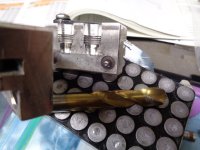As most of you know, I'm working on a cast bullet load for my 625 in 45 Colt. The 625 has a throat where .452" bullets will hang up when dropped in, but come out easily if pushed. I also have a 25-5 that has an over-sized cylinder where 5 out of 6 .454" bullets fit the same, but one cylinder seems to be even a bit larger.
Would trying the .454" bullets in the 625 with .452" cylinders make sense?
Would trying the .454" bullets in the 625 with .452" cylinders make sense?


